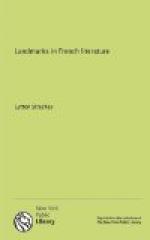Moliere’s genius was many-sided; he was a master not only of the smile, but of the laugh. He is the gayest of writers, and his farces, in their wild hilarity, their contagious absurdity, are perfect models of what a farce should be. He has made these light, frivolous, happy things as eternal as the severest and the weightiest works of man. He has filled them with a wonderful irresponsible wisdom, condensing into single phrases the ridiculousness of generations: ’Nous avons change tout cela.’—’Que diable allait-il faire dans cette galere?’—’Vous etes orfevre, Monsieur Josse.’ So effectually has he contrived to embalm in the spice of his humour even the momentary affectations of his own time that they have come down to us fresh as when they first appeared, and the Precieuses Ridicules—a skit upon the manners and modes of speech affected by the fops of 1650—still raises to-day our inextinguishable laughter. This is the obvious side of Moliere; and it is hardly in need of emphasis.
It is the more remote quality of his mind—his brooding melancholy, shot through with bitterness and doubt—that may at first sight escape the notice of the reader, and that will repay the deepest attention. His greatest works come near to tragedy. Le Tartufe, in spite of its patched-up happy ending, leaves an impression of horror upon the mind. Don Juan seems to inculcate a lesson of fatalistic scepticism. In this extraordinary play—of all Moliere’s works the farthest removed from the classical ideal—the conventional rules of religion and morality are exposed to a withering scorn; Don Juan, the very embodiment of the arrogance of intellect, and his servant Sganarelle, the futile and superstitious supporter of decency and law, come before us as the only alternatives for our choice; the antithesis is never resolved; and, though in the end the cynic is destroyed by a coup de theatre, the fool in all his foolishness still confronts us when the curtain falls.




